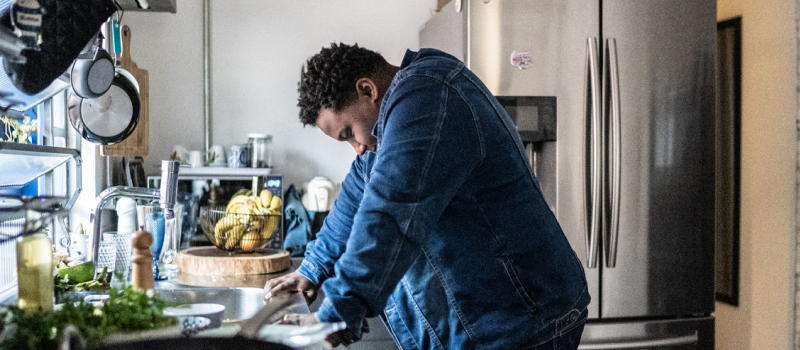
Table of Contents
What Is Reactive Abuse?

Written By: Alex Bachert, MPH

Clinically Reviewed By: Dr. Don Gasparini
Updated: July 3, 2024
6 min.
Despite what its name suggests, reactive abuse is actually a form of self-defense that some people take in response to ongoing harm in an abusive relationship.
Learn more about our Clinical Review Process
Table of Contents
“Reactive abuse” describes situations where a person who has endured sustained abusive behavior reacts aggressively towards their abuser. The abusive partner often manipulates this reaction to shift blame and create a false narrative of so-called “mutual abuse” (more on this below). However, this behavior is self-defense, a response to ongoing harm, and should not be equated with abusive behavior. Below, we will discuss reactive abuse, strategies to manage it, and the mental health toll of abuse.
Signs of reactive abuse
It can be challenging to recognize when you or a loved one are in an abusive relationship, but these three stages demonstrate what an abusive relationship with reactive abuse can look like.
1. Antagonism
The abuser deliberately provokes their partner, pushing them to react in anger or frustration. These habits may not seem harmful initially, but they can eventually cause a person to hit their breaking point. Here are a few examples of behaviors that can trigger reactive abuse:
- Asking you a personal or triggering question, especially around other people
- Posting or commenting on your social media in an intentionally triggering way
- Intentionally violating your emotional or physical boundaries
- “Forgetting” to do something intentionally
- Baiting you into arguments and then belittling your reaction
2. Proof
Once the partner reacts, the abuser quickly seizes the opportunity to use this reaction as “proof” that the partner is the abusive one. This can involve recording the outburst on video, taking photographs of any physical responses, or simply recounting the incident to friends, family, or authorities in a way that frames them as the victim. By capturing these moments of reactive behavior, the abuser constructs a narrative that supports their version of events and shifts attention away from their abusive actions.
However, abuse is fundamentally about power and control. The abuser, who holds the most power in the relationship, will use their partner’s reaction to manipulate and control the narrative.

We offer trauma-informed therapy for survivors of abuse
Begin virtual intensive therapy in as little as 24 hours.
3. Turning the tables
Turning the tables is a tactic frequently employed in reactive abuse. Here, the abuser shifts the blame onto their partner, claiming that the relationship problems or conflicts are due to the partner’s aggressive behavior. This tactic is used to deflect responsibility and perpetuate the cycle of abuse. By portraying their partner as the primary aggressor, the abuser not only avoids accountability but also reinforces their control over the narrative of the relationship. This manipulation can leave the partner feeling isolated, misunderstood, and doubting their own experiences of abuse.
Is there a difference between self-defense and mutual abuse?
In short — yes. You may have heard the term “mutually abusive” to describe a rocky or tumultuous relationship, but experts agree that the concept of mutual abuse does not exist.
Two people in a relationship can both exhibit unhealthy behaviors, but abuse stems from one person’s desire for power and control over another person. In an abusive relationship, the abuser will purposely behave in a cruel, violent, demeaning, or invasive manner toward their partner to create an imbalance of power.
The victim may eventually react to that abuse, but that response is considered to be self-defense. According to the National Domestic Violence Hotline, signs that your behavior is in self-defense include:
- You acted when you felt that your safety was at risk
- You acted as a way to try and re-establish your independence
- You’d like to change your behavior because you know it’s not who you are or healthy for a relationship
Self-defense
Abuse
Actions taken by someone to protect themselves from imminent harm or danger.
Actions that are cruel, violent, demeaning, or invasive to create an imbalance of power.
Mental health consequences of prolonged abuse
If you’ve ever been on the receiving end of abuse or witnessed a loved one in an abusive relationship, you know firsthand that prolonged abuse can significantly affect a person’s mental and physical health. Being in a relationship with abusive behavior patterns can cause long-term emotional trauma, such as post-traumatic stress disorder, as well as short-term symptoms like:
- Fear
- Shame
- Anxiety
- Confusion
- Hopelessness
- Powerlessness
- Guilt
Is there a link between reactive abuse and narcissism?
Reactive abuse can happen in various abusive relationships, including those involving narcissistic abuse. Narcissistic abuse is a form of emotional abuse used by people with narcissistic personality disorder (NPD) to control, exploit, and undermine others. While many people occasionally display narcissistic traits, those with NPD have an excessive sense of self-importance, a lack of empathy, and a need for constant admiration. In relationships, they may manipulate, gaslight, belittle, and control others for their own gain.
Narcissistic abusers often push their victims to provoke a reaction. When the victim reaches their breaking point and reacts with anger, frustration, or aggression, the narcissist uses this reaction to manipulate the situation further. They may portray themselves as the victim, justify their abusive behavior, and use the victim’s reaction as evidence to discredit their claims or deflect responsibility.
Narcissistic abuse is harmful and indicates a toxic relationship dynamic. Seeking professional help, such as therapy or support groups, can be crucial for victims to break free from this abusive cycle and regain their emotional well-being.

6 tips for how to deal with reactive abuse
Dealing with reactive abuse can be challenging, but there are steps you can take to protect yourself and find support.
1. Acknowledge the abuse
Recognize and admit that you are experiencing abuse. Understanding the situation is the first step toward finding a solution. Here are some signs that you’re in an abusive relationship:
- Hurtful, insulting, or demeaning communication
- Blame shifting
- Gaslighting
- Isolation
- Inconsistent behavior
- Manipulation
- Physical violence
2. Seek therapy
Seek professional help from a therapist or counselor who specializes in abuse. Talk therapy, such as cognitive behavioral therapy (CBT), can help people better understand their thoughts and feelings. CBT also teaches coping skills to deal with stress, distorted thoughts, and difficult abuse-related emotions.
3. Consult a helpline
If you need immediate support, consider one of the following helplines:
- The National Domestic Violence Hotline: Call 1-800-799-SAFE (7233) or Text “START” to 88788
- Love Is Respect Helpline: Call 1-866-331-9474 or Text “LOVEIS” to 22522
- Visit the NO MORE Directory to find additional resources near you
4. Talk to someone you trust
While not a replacement for therapy, sharing your experiences with a trusted friend or family member can be helpful. Talking about what you’re going through can provide emotional relief and help you gain perspective.
5. Lean on your support system
If you’re not ready to talk about the abuse, you can still prioritize spending time with people who treat you with respect. Abuse can be isolating, so staying in touch with friends and family is essential for emotional support.
6. Remember your worth and sense of self
Suffering from abuse can take a toll on your mental health and self-esteem. Find ways to prioritize your emotions to help you process the pain and regain your sense of self. For example, try grounding techniques like meditation, deep breathing, or journaling. These strategies can also be explored in therapy.

How Charlie Health can help
If you or a loved one are struggling with an abusive relationship, Charlie Health is here to help. Charlie Health’s virtual Intensive Outpatient Program (IOP) provides more than once-weekly mental health treatment for people and families dealing with serious mental health conditions, including trauma survivors. Our expert clinicians incorporate evidence-based therapies into individual counseling, family therapy, and group sessions. With this kind of holistic online therapy, managing your mental health is possible. Fill out the form below or give us a call to start healing today.



